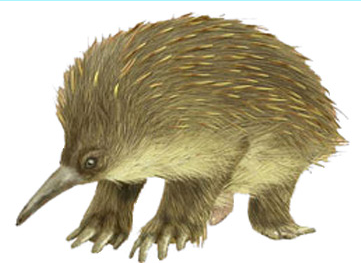To date, no archaeological evidence exists of megafauna that lived in the Tamar/Kanamaluka/ valley. Formal palaeontological excavations have not been done in this area and no fossils have been found. However, we do know that seven species of megafauna lived in other parts of Tasmania during the Pleistocene. One was a monotreme, and the other six were marsupials. It is possible that some, or all, of them inhabited this area of southern Sahul (Tasmania) when it was joined to the mainland.
Megalibgwilia ramsayi is a monotreme of the genus of echidna, known only from Australian fossils. It lived during the Pleistocene and became extinct about 50,000 years ago. Megalibgwilia fossils have been found in Tasmania and on the mainland.
Although they are described as ‘giant’ echidnas, they were more likely about the same size as the modern western long-beaked echidna but weighing twice as much. Their longer and more powerful front legs indicate that they were strong burrowers. They would probably have eaten insects and larvae, not just ants like modern echidnas.
Zygomaturus Tasmanicus

©Nobu Tamura via Wikimedia Commons
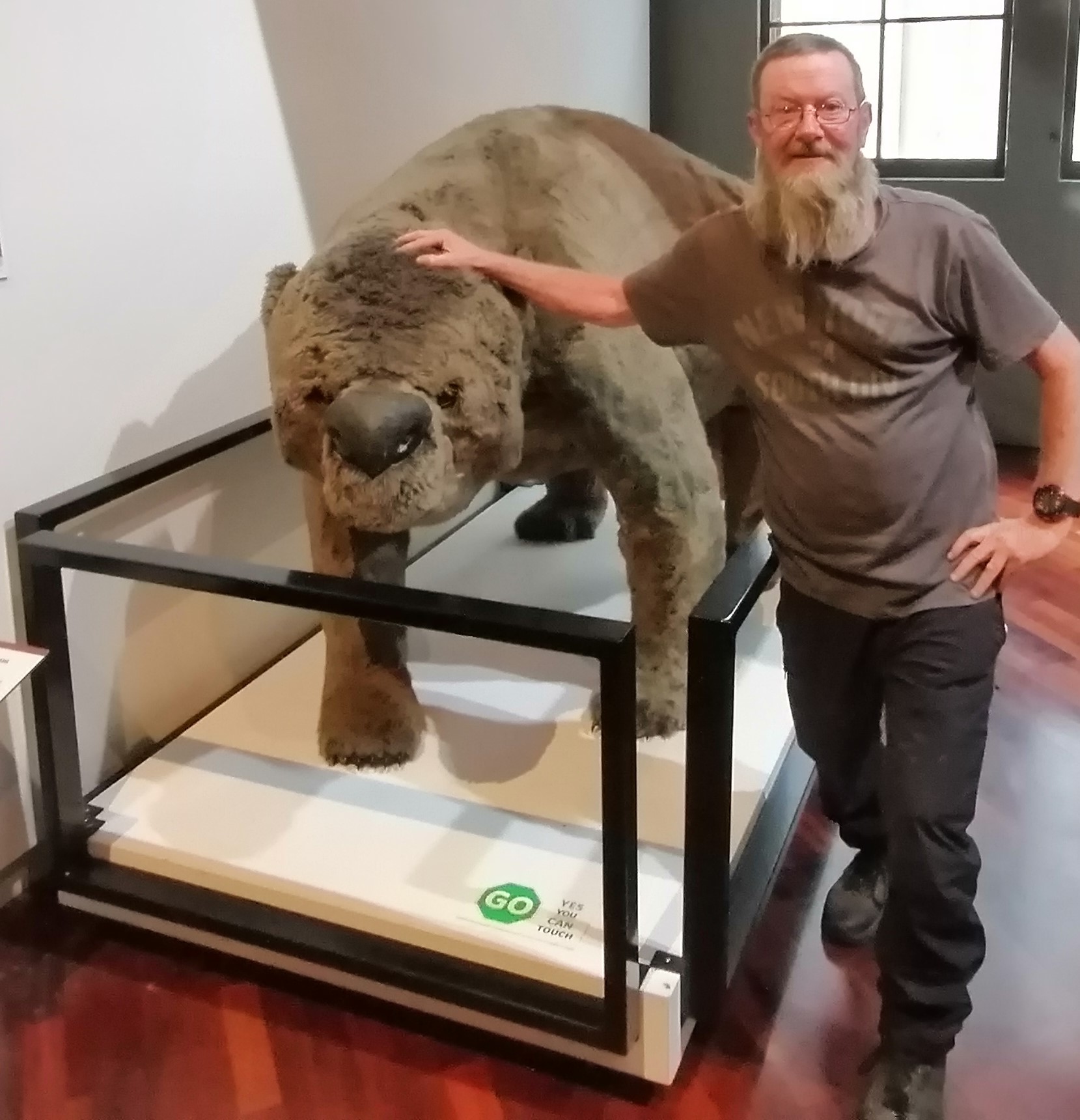
Geoff McLean giving ‘Zyggie’ a friendly pat.
Zygomaturus is often described as a ‘marsupial rhino’, closely related to the mainland Diprotodon. It was between 1.5 m (4.9 ft) tall and 2.5 m (8.2 ft) long and could weigh between 500 kg (1100 lbs) and 700 kg (1544 lbs). A 35,000-year-old specimen of Zygomaturus trilobus was found in the Willandra Lakes Region New South Wales. If the date for this specimen is accurate, it means it lived at around the same time as Mungo Man and Mungo Lady (42,000-40,000 BP) and is the latest known example of Australian Megafauna. [1]
In Tasmania, Zygomaturus skeletons have been found in various places that were once swamp-forests. In 1910, Mr E.C. Lovell was draining part of his land at Mowbray Swamp, (now named Mella, about 5kms from Smithton) and he found a complete skeleton of a Zygomaturus. The skeleton was carefully excavated under the expert supervision of Mr Hubert Hedley Scott, Curator of the Queen Victoria Museum in Launceston. It is now held by the Tasmanian Museum and Art Gallery. The Queen Victoria Museum and Art Gallery have a copy of the skeleton on display, and also a life size recreation of a Zygomaturus trilobus (affectionately known as ‘Zyggie’) that you can pat!
Palorchestes azael

©Nobu Tamura, Wikimedia Commons
Palorchestes azael was a diprotodontid which had short, retracted nasal bones suggesting it had a short trunk. Palorchestes was a browsing herbivore that probably fed on roots and leaves. It had powerful forelimbs and large, compressed claws that it may have used to pull up shrubs or tear at the bark of trees. It would have had a long, prehensile tongue (like a giraffe) that it used to manipulate leaves and other vegetation. Palorchestes lived in Tasmania, near marshes or shallow lakes surrounded by eucalypt woodland. [2]
Short-faced Kangaroos
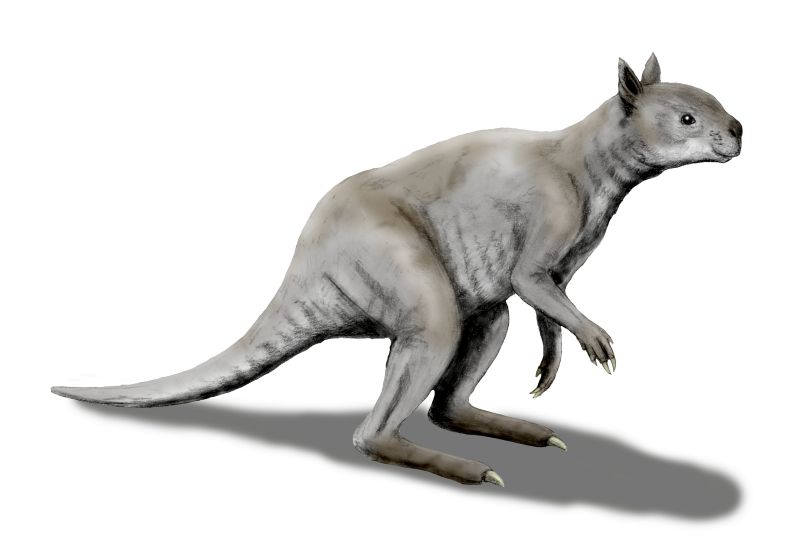
©Nobu Tamura, Wikimedia Commons
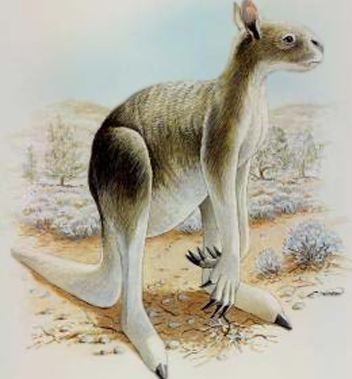
Image from Joyzine
Fossils of two different species of giant, short faced, browsing kangaroos, Metasthenurus newtonae and Simosthenurus occidentalis, have been found in Tasmania at Scotchtown Cave near Circular Head and at King Island. Their large, strong molars indicate they were omnivores. They are estimated to have weighed about 120 kilograms, standing at about the same height as large modern kangaroos, but with a heavier, more muscular body.
Another larger, short-faced, long-necked kangaroo called Protemnodon anak existed in Tasmania during the Pleistocene period and is thought to have been similar to modern day wallabies, but larger and more robust. These giant kangaroos weighed between 100 and 150 kg.
Thylacoleo carnifex
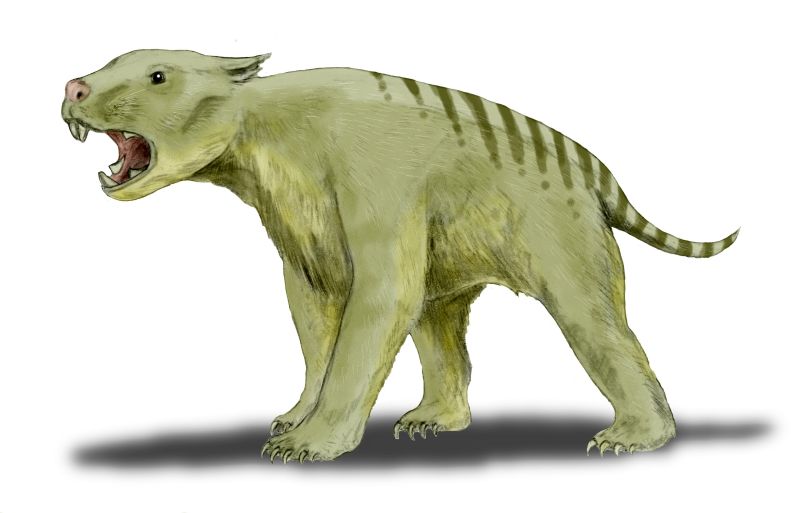
©Nobu Tamura, Wikimedia Commons
Thylacoleo carnifex, the carnivorous ‘marsupial lion’, was the largest mammal predator on the mainland and in Tasmania. It may have hunted other Pleistocene megafauna like the giant Diprotodon. Thylacoleo may have been an ambush predator or scavenger. It had enormous, slicing cheek teeth, large stabbing incisor teeth and a huge thumb claw that may have been used to disembowel its prey. Thylacoleo is estimated to have weighed between 90-160 kilograms, but the Tasmanian examples are smaller than those on the mainland. Most of the sites where Thylacoleo fossils have been found are thought to have been dry, open forest. Because it was a marsupial, it carried its young in its pouch.
Did Aboriginal People and megafauna coexist in Tasmania?
Archaeologists and palaeontologists are still arguing about whether Aboriginal People and megafauna co-existed in Tasmania during the Pleistocene Period. In 2008, one group claimed that megafauna and Aboriginal People lived at the same time.[3] This was strongly refuted in 2010[4] and again in 2017 by two other groups who argued that megafauna died out 1,000 years before the arrival of Aboriginal People in southern Sahul. [5] Unless archaeological evidence of human occupation (such as tools or cooking) and megafauna remains are found together and scientific dating of the evidence is conclusive, we will not know for sure whether Aboriginal People and megafauna coexisted in Tasmania.
Notes and references
[1] https://en.wikipedia.org/wiki/Zygomaturus
[2] Palorchestes fossils were also found at Riversleigh in Queensland, Northern Territory and Victoria but they did not exist at the same time. Over time they became larger.
[3] Turney, C. S.M, Flannery, T. F., Roberts, R. G., Reid, C., Fifield, L. K., Higham, T. F.G, & Ogle, N. (2008). Late-surviving megafauna in Tasmania, Australia, implicate human involvement in their extinction. Proceedings of the National Academy of Sciences of the United States of America, 105(34), 12150-12153.
[4] Cosgrove, R., Field, J., Garvey, J., Brenner-Coltrain, J., Goede, A., Charles, B., O’Connell, J. (2010). Overdone overkill – the archaeological perspective on Tasmanian megafaunal extinctions. Journal of Archaeological Science, 37, 2486-2503.
[5] Lima-Ribeiro, M. S., & Diniz-Filho, J. A. F. (2014). Obstinate overkill in Tasmania? The closest gaps do not probabilistically support human involvement in megafaunal extinctions. Earth-Science Reviews, 135, 59-64.

